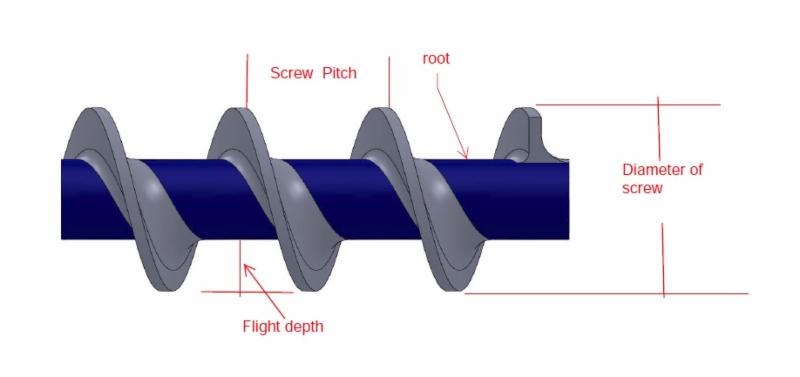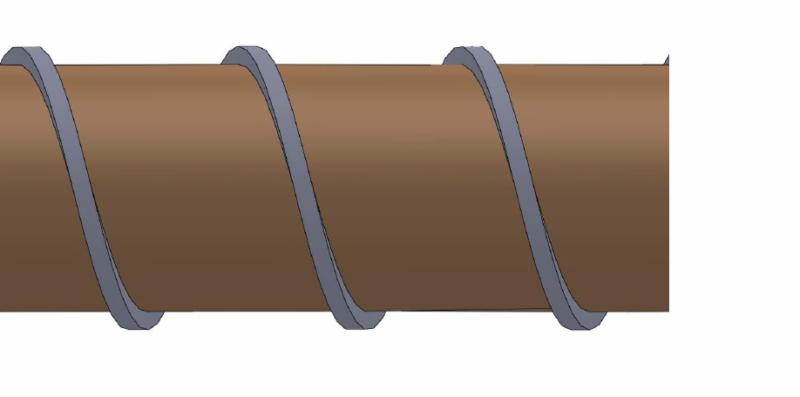|
common terminology?
The standard metering screw whether in an extruder or injection molding machine perform the same function and that is to convey, melt/soften, mix and heat the polymers to a uniform mix, temperature and homogenous product for either extrusion or molding purposes.
The standard metering screw, meaning it has a metering section, and a single helical flight that is continuous from the feed to meter section. It is important to note there are many types of screw designs available, and that these basics are meant as first step in understanding in this series.
The difference between an extrusion process and molding process is that in the extrusion process it is continuous, the screw is always rotating/pumping material forward, while that of the injection molding process is intermittent, meaning that it stops and starts and the screw itself moves/slides within the barrel.
The basis of screw design is to convey, mix and heat which is accomplished with the design of the screw. Most of which are divided into 3 sections, feed, transition and metering. The screw itself is also composed of the flights, root and spacing of the flights in relationship to the diameter of the screw.
Relationships in the screw are that the length is usually measured by the diameter, meaning that a screw may have a call out of 24:1, 16:1, 32:1 which means the it has 24 diameters of length per the first set of numbers and if the screw diameter is 40mm than taking 40 times 24 this would equal the working length of the screw. This relationship than allows the manufactures and processors to create screws the same for different diameters, meaning 24:1 at 70mm diameter and 40mm diameter are similar in working the material, but different in the volume of material they are capable of processing.
Fig 1.

Figure 1 shows an exaggerated view of a screw with its three sections, the feed, compression and metering sections. It also illustrates the length of the screw which is the working section of the overall screw, note that at the end attached to the feed section would be a spline section which is inserted into the drive mechanism to rotate the screw.
Fig 2.

Figure 2 illustrates the typical call out for the screw. This shows the diameter, which is the top of the flights and the root which will change as it goes from the feed section (shown above) to the transition and then the metering section.
Fig. 3.

Figure 3 illustrates the metering section which has the shallow flights, and in screw design this is the first section which is designed for the material, to be processed. All other sections are than calculated off this section. Thus in extrusion this section begin the pump is used to calculate the volume per hour at a set RPM. This is also used in molding for the creation of shot size and volume of shot.
The compression ratio is the relationship of this sections volumetric change as compared to the feed section. In meaning that if the screw has a 3:1 compression ratio the volume in one flight of the feed is 3 times that of the metering section. The compression ratio imparts work onto the material, meaning that the higher the ratio the more work to be put into the materials. An example may be that PVC uses a low compression screw of 1.5:1 while a material such as nylon might require 4:1 to process.
**There are many factors to proper screw selection, for material compression ratio is only one of those.
In general material is picked up in the feed section as the hopper is located above the end of this section and it is conveyed as the screw rotates forward, becoming more compressed, and heating up. As it enters the compression section it may have started to melt/soften but there is still a large portion of unmelted polymer which is then worked, compressed, and melted/soften hopefully to a uniform consistency. As it enters the metering section this section finishes off any final melt/softening effect of the material. This section also in extrusion imparts the pumping action on the material to the die while in molding provides the flow/volume for shot size though the check ring mechanism.
To be continued:
SLSILVEY
27042015.01.1
Visit our website
|